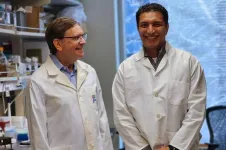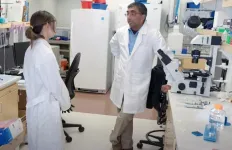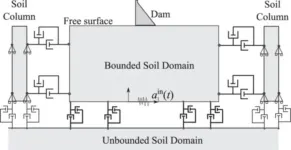(Press-News.org) UNIVERSITY PARK, Pa. — Astronomers have discovered a planet that has the most oblong orbit ever found among transiting planets. The exoplanet’s extreme circuit — which looks closer to a cucumber than a circle — follows one of the most drastically stretched-out orbits of all known exoplanets, planets that orbit stars outside our solar system. It is also orbiting its star backwards, lending insight into the mystery of how close-in massive gas planets, known as hot Jupiters, form, stabilize and evolve over time.
The research, led by Penn State scientists, was published today (July 17) in the journal Nature.
“We caught this massive planet making a sharp, hairpin turn during its close passage to its star,” said Suvrath Mahadevan, the Verne M. Willaman Professor of Astronomy at Penn State and author on the paper. “Such highly eccentric transiting planets are incredibly rare — and it's really amazing that we were able to discover the most eccentric one.”
Mahadevan explained that the term “eccentric” refers to the shape of a planet’s orbit, which is measured on a scale from zero to one, with zero being a perfectly circular orbit. This exoplanet, named TIC 241249530, has an orbital eccentricity of 0.94, making it more eccentric than the orbit of any other transiting exoplanet ever found. For comparison, Pluto’s highly elliptical orbit around the sun has an eccentricity of 0.25; Earth’s eccentricity is 0.02. Such an extreme orbit, Mahadevan explained, would cause temperatures on the planet to vary between that of a summer’s day at the farthest point in its orbit to blazing hot at its closest approach.
To add to the unusual nature of the exoplanet’s orbit, the team also found that it’s orbiting backwards, meaning in a direction opposite to the rotation of its host star. This is not something that astronomers see in most other exoplanets, nor in our own solar system, and it helps inform the team’s interpretation of the exoplanet’s formation history.
“While we can’t exactly press rewind and watch the process of planetary migration in real time, this exoplanet serves as a sort of snapshot of the migration process,” Arvind Gupta, NOIRLab postdoctoral researcher and lead author of the paper, who conducted the research as a doctoral student at Penn State, said in a NOIRLab release. “Planets like this are hard to find and we hope it can help us unravel the hot Jupiter formation story.”
At present there are over 5,600 confirmed exoplanets in just over 4,000 star systems. Within this population, about 300 to 500 exoplanets fall into the curious class known as hot Jupiters — large, Jupiter-like exoplanets that orbit very close to their star, much closer than Mercury is to our sun. How hot Jupiters end up in such close orbits is a mystery, but astronomers suspect that they begin in orbits far from their star and then migrate inward over time. The early stages of this process have rarely been observed, but with this new analysis of an exoplanet with an unusual orbit, astronomers are one step closer to unraveling the hot Jupiter mystery.
“Astronomers have been searching for exoplanets that are likely precursors to hot Jupiters, or that are intermediate products of the migration process, for more than two decades, so I was very surprised — and excited — to find one,” Gupta said.
The discovery and characterization of the exoplanet was enabled by three instruments built at Penn State: the NASA-funded NEID spectrograph, the Habitable Zone Planet Finder spectrograph and a photometric diffuser. All three instruments allow researchers to observe and analyze light emitted by the exoplanet.
The researchers first detected the planet using NASA’s Transiting Exoplanet Survey Satellite (TESS) in January 2020, which revealed a dip in a star’s brightness consistent with a single Jupiter-sized planet passing in front of the star. To confirm the nature of these fluctuations and eliminate other possible causes, a team of astronomers used two instruments on the WIYN 3.5-meter Telescope at the U.S. National Science Foundation (NSF) Kitt Peak National Observatory (KPNO), a program of NSF NOIRLab.
The team first utilized the NASA-funded NN-EXPLORE Exoplanet and Stellar Speckle Imager (NESSI) in a technique that helps to “freeze out” atmospheric twinkling, which showed that there were no extraneous stars nearby that could have confused the TESS measurements. Then, using the HPF and NEID spectrographs, the team observed how TIC 241249530’s spectrum, or wavelengths of its emitted light, shifted as a result of the exoplanet orbiting it.
“It's so exciting to see such great science coming out of NEID within just a few years of operations,” said Andrea Lin, a co-author on the paper and doctoral student at Penn State who helped construct and commission the NEID spectrograph. “We’re just getting started and I'm looking forward to seeing what we can accomplish in the future.”
Detailed analysis of how the velocity of the star changes throughout the planet’s six-month orbital period confirmed that the exoplanet is approximately five times more massive than Jupiter, and that it is orbiting along an extremely eccentric path.
“This is the most eccentric transiting planet known and will prove to be as important as the previous record holder, HD80606b, which likewise has a wacky orbit highly misaligned with its host star's spin,” said Jason Wright, Penn State professor of astronomy and astrophysics, who supervised the project while Gupta was a doctoral student at the university. “These two highly eccentric planets have been ‘caught in the act’ of evolving towards hot Jupiter status. Like HD80606b, this planet is many times Jupiter's mass, suggesting this channel for forming hot Jupiters might be one only the most massive planets can take.”
Together, these two examples observationally affirm the idea that higher-mass gas giants evolve to become hot Jupiters as they migrate from highly eccentric orbits toward tighter, more circular orbits.
"We’re especially interested in what we can learn about the dynamics of this planet's atmosphere after it makes one of its scorchingly close passages to its star," Wright said. "Telescopes like NASA's James Webb Space Telescope have the sensitivity to probe the changes in the atmosphere of this newly discovered exoplanet as it undergoes rapid heating, so there is still much more for the team to learn about the exoplanet."
Other Penn State co-authors are Jessica Libby-Roberts, a postdoctoral fellow, Megan Delamer, a graduate student, and Donald Schneider, distinguished professor of astronomy and astrophysics. A full list of authors is available on the paper.
This work was funded by Penn State, the National Aeronautics and Space Administration (NASA), The Center for Exoplanets and Habitable Worlds, NASA-NSF Exoplanet Observational Research (NN-EXPLORE), NASA Exoplanet Exploration Program, The NASA Ames Research Center, The Robert Martin Ayers Sciences Fund, The U.S. National Science Foundation (NSF), The Agencia Estatal de Investigación of the Ministerio de Ciencia e Innovación, the Nicolaus Copernicus University in Toruń, Polan, The Spanish Ministry of Science and Innovation (MICINN) through the Spanish State Research Agency, The TESS Guest Investigator Program, The Heising-Simons Foundation, the University of Texas at Austin, Ludwig-Maximillians-Universitaet Muenchen and Georg-August Universitaet Goettingen.
END
Exoplanet caught in ‘hairpin turn’ signals how high-mass gas giants form
An exoplanet’s elongated, backwards orbit holds clues to the formation history and future trajectories of hot Jupiters
2024-07-17
ELSE PRESS RELEASES FROM THIS DATE:
Switching off inflammatory protein leads to longer, healthier lifespans in mice
2024-07-17
Scientists at the Medical Research Council Laboratory of Medical Science and Imperial College London have discovered that ‘switching off’ a protein called IL-11 can significantly increase the healthy lifespan of mice by almost 25%.
The scientists, working with colleagues at Duke-NUS Medical School in Singapore, tested the effects of IL-11 by creating mice that had the gene producing IL-11 (interleukin 11) deleted. This extended the lives of the mice by over 20% on average.
They also treated 75-week-old mice – equivalent to the age of about 55 years in humans – with an ...
New gene therapy for muscular dystrophy offers hope
2024-07-17
A new gene therapy treatment for Duchenne muscular dystrophy shows promise of not only arresting the decline of the muscles of those affected by this inherited genetic disease, but perhaps, in the future, repairing those muscles.
The UW Medicine-led research focuses on delivering a series of protein packets inside shuttle vectors to replace the defective DMD gene within the muscles. The added genetic code will then start producing dystrophin, the protein lacking in patients with muscular dystrophy.
Currently, there is no cure for the disease ...
Scientists bridge the 'valley of death' for carbon capture technologies
2024-07-17
A major obstacle for net zero technologies in combatting climate change is bridging the gap between fundamental research and its application in the real world.
This gap, sometimes referred to as ‘the valley of death’, is common in the field of carbon capture, where novel materials are used to remove carbon dioxide from flue gasses produced by industrial processes. This prevents carbon from entering the atmosphere, helping to mitigate the effects of climate change.
Chemists have proposed and ...
Genome recording makes living cells their own historians
2024-07-17
Genomes can now be entrusted to store information about a variety of transient biological events inside of living cells, as they happen, like a flight recorder collecting data from an aircraft.
“Our method, which goes by the acronym ENGRAM, aims to turn cells into their own historians,” said Dr. Jay Shendure, a professor of genome sciences at the University of Washington School of Medicine and scientific director of the Brotman Baty Institute for Precision Medicine. Shendure led the effort, together with Wei Chen, a former graduate student, and Junhong Choi, a former postdoctoral fellow. Junhong ...
USC Schaeffer Institute launches new initiative to improve public policy through behavioral science
2024-07-17
The USC Schaeffer Institute for Public Policy & Government Service announced a new initiative today that leverages behavioral science to create more effective public policy.
The Behavioral Science & Policy Initiative at the USC Schaeffer Institute will conduct research to understand people’s beliefs and behaviors to create policies and communication that better fit people’s needs. The initiative will focus on policy topics such as climate change, health, and food insecurity.
“We want to help policymakers make a difference,” said Wändi Bruine de Bruin, the initiative’s ...
Groundwater is key to protecting global ecosystems
2024-07-17
(Santa Barbara, Calif.) — Where hidden water tables meet the Earth’s surface, life can thrive even in the driest locations. Offering refuge during times of drought, shallow groundwater aquifers act like water savings accounts that can support ecosystems with the moisture required to survive, even as precipitation dwindles. As climate change and human water use rapidly deplete groundwater levels around the world, scientists and policy makers need better data for where these groundwater-dependent ecosystems exist.
Now, a new study maps ...
A new approach to accelerate the discovery of quantum materials
2024-07-17
– By Michael Matz
Researchers at the Department of Energy’s Lawrence Berkeley National Laboratory (Berkeley Lab) and several collaborating institutions have successfully demonstrated an innovative approach to find breakthrough materials for quantum applications. The approach uses rapid computing methods to predict the properties of hundreds of materials, identifying short lists of the most promising ones. Then, precise fabrication methods are used to make the short-list materials and further ...
Influenza viruses can use two ways to infect cells
2024-07-17
Most influenza viruses enter human or animal cells through specific pathways on the cells’ surface. Researchers at the University of Zurich have now discovered that certain human flu viruses and avian flu viruses can also use a second entry pathway, a protein complex of the immune system, to infect cells. This ability helps the viruses infect different species – and potentially jump between animals and humans.
The majority of type A influenza viruses circulating in birds and pigs aren’t normally a health ...
Engineering resilience: Advanced FEM enhances earthquake impact assessment
2024-07-17
In a significant advancement for geotechnical engineering, a refined space-time finite element method (v-ST/FEM) has been introduced to tackle the complex dynamics of soil-structure interaction during seismic events. This new approach allows for more accurate simulations of the response of earth structures to earthquake vibrations, marking a crucial step in improving infrastructure resilience against natural disasters.
Designing structures like dams, tunnels, and embankments to withstand transient loads from sources such as earthquakes, high-speed trains, and explosions requires robust dynamic soil-structure interaction (SSI) analysis. Traditional methods often fall short in handling ...
The Vps21 signaling pathway regulates white-opaque switching and mating in Candida albicans
2024-07-17
This study was led by Dr. Guanghua Huang (School of Life Sciences, Fudan University). The team discovered that the conserved Vps21 signaling pathway plays critical roles in the regulation of white-opaque switching and mating in Candida albicans, a major human fungal pathogen.
Candida albicans is able to cause cutaneous diseases as well as life-threatening systemic infections in humans. It has multiple cellular morphologies and can undergo transitions among different morphologies to adapt to environmental changes. White-opaque transitions represent a typical morphological phenotypic switching system ...
LAST 30 PRESS RELEASES:
Manganese gets its moment as a potential fuel cell catalyst
“Gifted word learner” dogs can pick up new words by overhearing their owners’ talk
More data, more sharing can help avoid misinterpreting “smoking gun” signals in topological physics
An illegal fentanyl supply shock may have contributed to a dramatic decline in deaths
Some dogs can learn new words by eavesdropping on their owners
Scientists trace facial gestures back to their source. before a smile appears, the brain has already decided
Is “Smoking Gun” evidence enough to prove scientific discovery?
Scientists find microbes enhance the benefits of trees by removing greenhouse gases
KAIST-Yonsei team identifies origin cells for malignant brain tumor common in young adults
Team discovers unexpected oscillation states in magnetic vortices
How the brain creates facial expressions
Researchers observe gas outflow driven by a jet from an active galactic nucleus
Pitt student finds familiar structure just 2 billion years after the Big Bang
Evidence of cross-regional marine plastic pollution in green sea turtles
Patients with clonal hematopoiesis have increased heart disease risk following cancer treatment
Stem cell therapy for stroke shows how cells find their way in the brain
Environment: Up to 4,700 tonnes of litter flows down the Rhine each year
Maternal vaccine receipt and infant hospital and emergency visits for influenza and pertussis
Interim safety of RSVpreF vaccination during pregnancy
Stem cell engineering breakthrough paves way for next-generation living drugs
California grants $7.4 million to advance gene-edited stem cell therapy for Friedreich’s ataxia
Victoria’s Secret grant backs cutting-edge ovarian cancer research
Research paves the way for safer colonoscopy bowel prep for people with compromised gut health
JMIR Publications and Sweden's National Library announce renewal and expansion of flat-fee unlimited open access partnership for 2026
A new 3D-printed solar cell that’s transparent and color-tunable
IV iron is the cost-effective treatment for women with iron deficiency anemia and heavy menstrual bleeding
Doing good pays off: Environmentally and socially responsible companies drive value and market efficiency
City of Hope and Cellares to automate manufacturing of solid tumor CAR T cell therapy
Short-circuiting pancreatic cancer
Groundbreaking mapping: how many ghost particles all the Milky Way’s stars send towards Earth
[Press-News.org] Exoplanet caught in ‘hairpin turn’ signals how high-mass gas giants formAn exoplanet’s elongated, backwards orbit holds clues to the formation history and future trajectories of hot Jupiters










